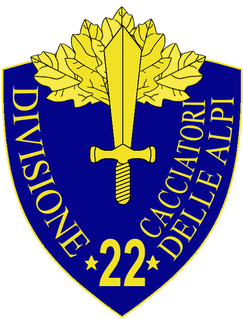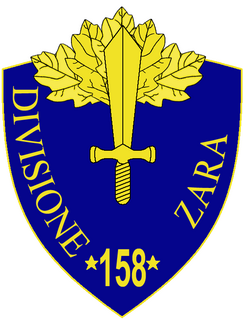History
The then Murgia division has participated in the Italian invasion of Albania as part of the XXVI Corps, landing partially in Durrës 7 April 1939 and spreading to Vlorë, Fier, Tepelenë, Patos-Marinza Oil Field and Kuçova oil field by 9 April 1939. 25 April 1939, the division headquarters were relocated to Gjirokastër with separate detachments in Berat, Tepelenë, Këlcyrë and Përmet covering the southern Albanian border.
At the beginning of Greco-Italian War 28 October 1940, the Ferrara division was stretched from Aoös valley to Mal Stugarë mount. It was expected in the case of the war to act offensively, advancing at Gjirokastër-Kalpaki-Ioannina direction. 30 October 1940, the division has entered few hundred meters into a Greek territory near Kakavia and stopped at Fitóki Potamós stream (tributary of Drino). Advancing by road, it was able to capture a railroad junction at Kalpaki, but failed to dislodge town garrison immediately. Greek resistance, initially weak, has grown rapidly, and Ferrara division was fought to halt, both because of enemy resistance and adverse weather turning a few passable roads and trails into the muddy traps. On the right flank, 1–3 November 1940, a battle was fought for the control of mountain chain near Mesovuni mount. But then the outnumbered Greek have retreated to the Thyamis river. The Italian forces have fought their way across Thyamis into the town of Chrisorrachi few kilometres south of Kalpaki 5 November 1940. But at the critical road junction of Kalpaki Italians were halted just 500 metres from city centre 6 November 1940.
The Greek, reinforced by aviation and artillery, counter-attacked during 6–7 November 1940. 10 November 1940 the defence of Ferrara division have failed on several points. 14 November 1940, parts of division were nearly surrounded, and started a retreat 16 November 1940. The division then rapidly rolled back to the Delvinaki-Fitóki Potamós stream line. Attacks and counter-attacks continued with the increasing odds against Italians, until the entire left flank of the Ferrara division was defeated 20 November 1940. At this point, the remnants of division held only a small sliver of Greek territory near Vesania and were ordered to retreat from increasingly untenable positions to Pontikates area. But these positions were abandoned too 26 November 1940, and the remnants of the Ferrara division were pushed south, out of Greece to the Drino river, making a stand at Radat and all along the way. The Ferrara division suffered a severe defeat at Radat 27 November 1940, and was relieved from the front line duty as 37th Infantry Division Modena has come as reinforcements 3 December 1940. The Ferrara division was temporarily relocated to Gjirokastër, but soon was forced back to fight as rearguard of defeated Modena division. 6–7 December 1940, it fought a defensive battle south of Tepelenë, at the confluence of the Aoös and Drino rivers. 14–16 December 1940, the Greek were able to capture a dominant height of Maja e Buzë Derrit, forcing the Ferrara to perform a costly counter-attacks until the height was re-captured. Until 10 January 1941, the fighting remained dynamic, although no particular gains were recorded on either side. Following a successful skirmish 10 January 1941, the Greek have renewed their onslaught 21 January 1941. By 27 January, when the 58th Infantry Division Legnano has arrived to the Italian side, a number of positions were lost, but Italian reinforcements have stabilized the situation, resulting in gradual reduction of military activities during February, 1941. [3] 7 March 1941, Greek forces have tried to attack at Lekël, but were repulsed.
16 April 1941, the Ferrara division have started a general advance near the Maja e Buzë Derrit. The division has quickly captured positions in the Drino valley, reaching soon the Gjirokastër-Libohovë line where it stayed until August, 1941. Afterward it was transferred to Vlorë-Tirana-Elbasan area. In the beginning of January, 1942, the Ferrara division was tasked with coastal defence duty in sector from Seman River to Durrës. In April, 1942, it was transferred again, this time to Montenegro, with headquarters in Nikšić (later moved to Cetinje), and detachments in Danilovgrad, Podgorica, and Šavnik.
Form 14 May 1943 to 16 June 1943, it together with German troops has participated in the fighting with Yugoslav partisans. A particularly bloody clash was recorded 16 May 1943 near Župa, in border region of now Bosnia and Herzegovina. The division disintegrated following the Armistice of Cassibile 8 September 1943, and was officially dissolved 25 September 1943.

The 5th Alpini Division Pusteria was a light Infantry division of the Italian Army, specializing in Mountain Combat. The Alpini are a mountain infantry corps of the Italian Army, that distinguished itself in combat during World War I and World War II. The division was formed in 1935.

The 19th Infantry Division Venezia was a mountain infantry division of the Regio Esercito was raised in 1934 to serve in the Second Italo-Ethiopian War under the name Gavinana division. It was demobilized and reduced to the brigade in July, 1936, but again mobilized 15 April 1939, under the "19th Infantry Division Venezia" name. The only difference between line infantry divisions and mountain infantry divisions was that the latter's artillery was carried by pack mules instead of the standard horse-drawn carriages. Italy's real mountain warfare divisions were the six alpine divisions manned by the "Alpini" mountain troops. In October–November 1943, it has gradually get transformed into the partisan Garibaldi division fighting together with Yugoslav Partisans against Axis.

The 24th Infantry Division Pinerolo was an infantry division of the Italian Army during World War II.

The 36th Infantry Division Forlì was a mountain infantry Division of the Italian Army during World War II. The division was formed as infantry division 31 March 1939, from the men mostly taken from the infantry brigade Monferrato. The men that formed this division were drafted in the Langhe, a geographical region in southern Piedmont. The only difference between line infantry divisions and mountain infantry divisions was that the latter's artillery was carried by pack mules instead of the standard horse-drawn carriages. Italy's real mountain warfare divisions were the six alpine divisions manned by the "Alpini" mountain troops.

The 6th Infantry Division Cuneo was an infantry division of the Italian Army during World War II. The Division was formed on 24 May 1939 in Milan, largely from the parts of 58th Infantry Division Legnano. The Cuneo Division was part of the III Corps, First Army that took part in the Italian invasion of France and the 26th Corps during Greco-Italian War.

The 7th Infantry Division Lupi di Toscana was an infantry division of the Italian Army during World War II. It was in 1938 formed as binary (2-regiment) division from infantry brigade in the city of Brescia. Despite the name, the division was formed by men from Lombardy, especially from Brescia, Bergamo and the surrounding valleys.

The 12th Infantry Division Sassari was an Infantry Division of the Italian Army during World War II. After the end of World War I the Italian Army disbanded all brigades raised during the war with the exception of the Sassari Infantry Brigade and three further brigades, which also had distinguished themselves during the war: Liguria, Arezzo and Avellino. The brigade moved to Trieste as part of the 12th Infantry Division Timavo'. In 1926 the brigade gained the 12th Infantry Regiment Casale and changed its name to XII Infantry Brigade. Along with the 34th Artillery Regiment the brigade were the only units of the 12th Division. In 1939 the brigade lost the 12th Infantry regiment and was renamed 12th Infantry Division Sassari. This binary division consisted of only two infantry regiments and the 34th Field Artillery Regiment. To increase the weak strength of the division in 1941 the division was joined by the 73rd Blackshirt Assault Legion Boiardo, a battalion sized militia unit of the Italian Fascist Party.

The 13th Infantry Division Re ("King") was an Infantry Division of the Italian Army during World War II. The Re Division was mobilized in June 1940 in Friuli

The 14th Infantry Division Isonzo was an infantry division of the Italian Army during World War II. The division was formed 24 May 1939. It surrendered to German forces on 11 September 1943.

The 15th Infantry Division Bergamo was an infantry division of the Italian Army during World War II. It was formed 24 May 1939 in Opatija.

The 18th Infantry Division Messina was an infantry division of the Italian Army during World War II. It was formed 24 May 1939 in the Fano area on the Italian Adriatic sea coast and was dissolved by Germans 13 September 1943 in Croatia.

The 21st Infantry Division Granatieri di Sardegna was an infantry division of the Italian Army during World War II. The Granatieri di Sardegna Division can trace its origins to 1659 when the Duke Carlo Emanuele II of Savoy formed a regiment of Guards. It became a unit in the national army in 1866.

The 22nd Infantry Division Cacciatori delle Alpi was an infantry division of the Italian Army during World War II. The Cacciatori delle Alpi was mobilized for war in June 1939 and was dissolved 11 September 1943.

The 32nd Infantry Division Marche was a mountain infantry division of the Italian Army during World War II. It was formed 22 February 1939 in Conegliano as Division 32a Marche, based on earlier infantry brigade Marche. The only difference between line infantry divisions and mountain infantry divisions was that the latter's artillery was carried by pack mules instead of the standard horse-drawn carriages. Italy's real mountain warfare divisions were the six alpine divisions manned by the "Alpini" mountain troops.

The 37th Infantry Division Modena was a mountain Infantry Division of the Italian Army during World War II. It was formed 25 March 1939, from the parts of the Territorial Division Imperia 5a. It was made up entirely of men from Genoa and Liguria. The only difference between line infantry divisions and mountain infantry divisions was that the latter's artillery was carried by pack mules instead of the standard horse-drawn carriages. Italy's real mountain warfare divisions were the six alpine divisions manned by the "Alpini" mountain troops.

The 48th Infantry Division Taro was an infantry division of the Italian Army during World War II. It was formed on 12 September 1939 in Catanzaro and ceased to function on 8 September 1943 in Toulon.

The 49th Infantry Division Parma was an infantry division of the Italian Army during World War II. The Parma Division was a regular division of the Italian Army, formed 12 September 1939 in Macerata, and dissolved 8 September 1943 in Vlorë.

The 158th Infantry Division Zara was a regular infantry division of the Italian Army during World War II. The Zara Division formed in March 1942, was a garrison division stationed on the Dalmatian coast. It surrendered to the Germans after the Italian surrender to the Allies in September 1943.

The 57th Infantry Division Lombardia was a regular infantry division of the Italian Army during World War II. It was formed on 24 May 1939 in Pula and disbanded on 8 September 1943.

The 154th Infantry Division Murge was an infantry division of the Italian Army during World War II. The Murge Division was a garrison division formed in April 1942. It was sent to Dalmatia as an occupation force and took part in anti-Partisan operations. It took part in the Battle of the Sutjeska and then had to be withdrawn after suffering heavy losses in fighting with the Partisans. It was disbanded in September 1943, following the Italian surrender to the Allies.




















